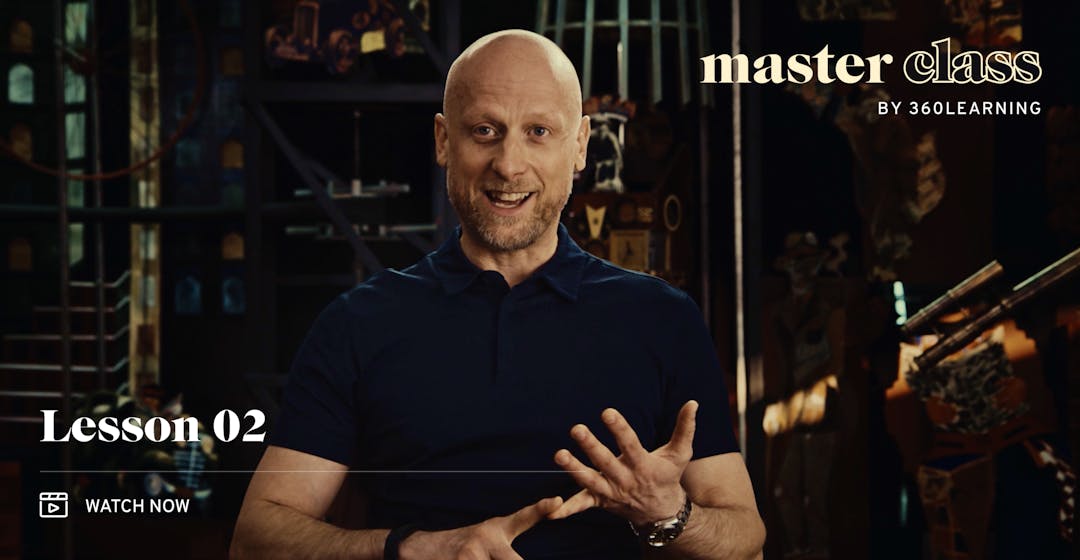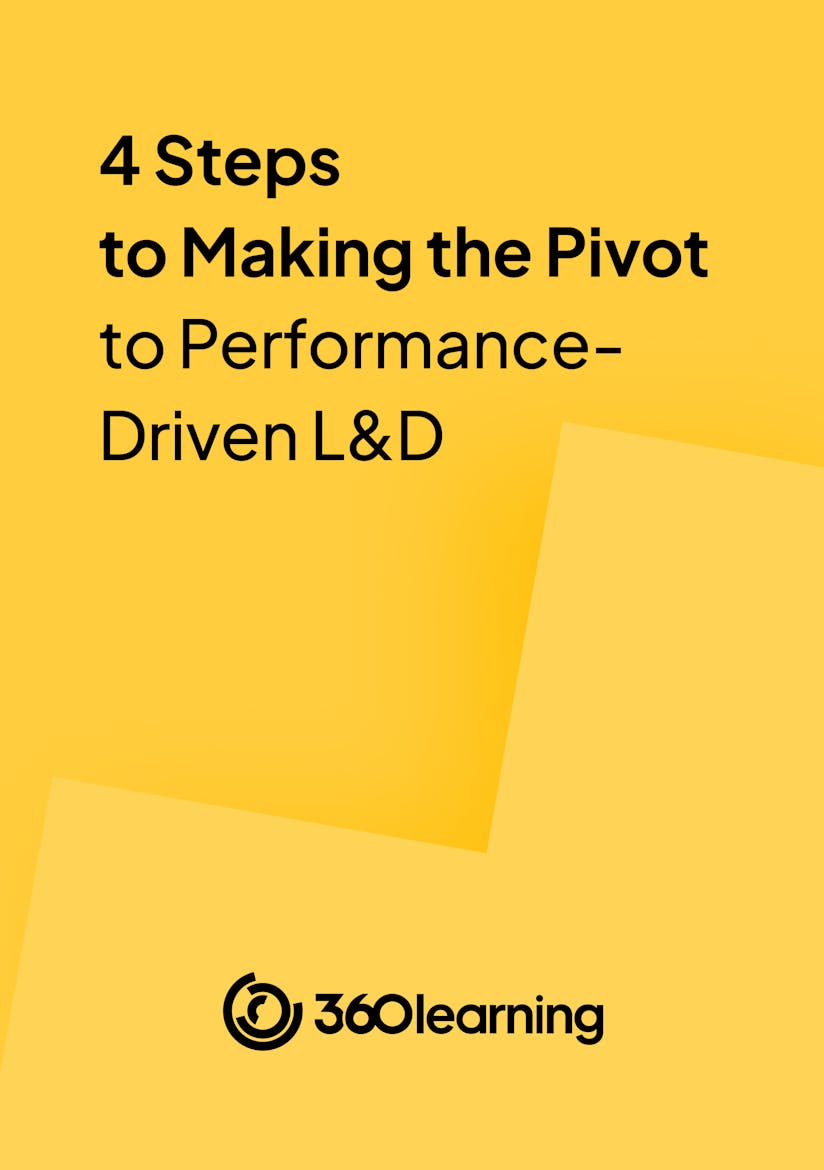
L&D Master Class Lesson 2: Our 4-Step Guide to Supporting Learners During Moments of Transition and Adaptation
At its core, L&D is fundamentally about helping people thrive in unfamiliar and demanding situations. Strip away all the theory, tools, and technology, and that’s what we’re all here to do.
So, how can you use digital-first learning to better offer this support? And how can you match this support to solving urgent business needs?
In this second lesson of our L&D master class, David James walks you through his four crucial steps to helping learners thrive during moments of transition and adaptation, and explains why an impactful learning strategy should focus on people, not topics.
Missed Episode 1 of our L&D master class? Check it out here!
How digital-first L&D can help people to transition and adapt
*This content is provided by 360learning, an independent company, with no affiliation with the “MasterClass” brand.
1. Recognize that skills are developed on the job, not in the classroom
One common misheld belief that’s holding L&D back from embracing digital-first learning is the idea that skills can’t be developed digitally, or that they are developed in the classroom. As David explains, this is simply not the case.
“Skills aren’t developed in the classroom,” he says. “They are developed while and where people work, when they butt up against unfamiliar situations and challenges, or when they try something that doesn't work.”
As David notes, these situations are perfect for digital-first learning. That’s because digital solutions can be accessed when and where people are working when they face these unfamiliar situations and challenges for the very first time.
“If we focus on what people are trying to do and the skills they're trying to practice, we can focus our attention on getting as close to the point of need as we possibly can. This way, we can help shape the way people think about the interaction, and then how they actually go about doing it for the first time.”
As David notes, top performers rarely show up in the classroom for formal training. There are a few reasons for this: these superstars might be learning from their peers, or benefitting from a line manager who takes their development seriously.
“These top performers are also learning from the culture of the organization and figuring out what it is that they need to do in order to be successful by exhibiting those expected or rewarded behaviors. But they're certainly not engaging in formal learning.”
According to David, to better support learners to develop this cultural aptitude, we need to reframe our assessment of learning needs.
Looking for some tips on pivoting to performance-driven L&D? Check out our four-step playbook for achieving more impactful L&D.

Impactful, demonstrable L&D in 4 simple steps
By providing your contact info, you agree to receive communications from 360Learning. You can opt-out at any time. For details, refer to our Privacy Policy.
If we focus on what people are trying to do and the skills they're trying to practice, we can focus our attention on getting as close to the point of need as we possibly can.
2. Reframe your assessment of learning needs
As David says, L&D teams have focused for too long on running learning programs because they are expected–and often well-attended–without considering whether they match learning needs.
“We've had our schedule of programs and we've run enough of these to fill them, but it's very rare that's going to actually meet the need of the individual for what it is that they need when they actually need it.”
In David's experience, digital technology offers a big opportunity to change this: but first, we have to change the way we perceive and overvalue classroom learning. We can do this by really thinking about the people we’re seeking to influence.
“People need our help when they face unfamiliar situations and challenges as they transition into our organization, as they transition through roles and then progress, and also when we expect them to adapt.”
For David, providing this support means making the shift from focusing on learning topics to focusing on the support people really need.
People need our help when they face unfamiliar situations and challenges.
3. Make the shift from topic-centric to people-centric L&D
As David explains, giving people the right support during moments of transition and adaptation means shifting from a topic-centric model of L&D to one that truly focuses on learner needs.
“When we think about new starters joining our organization, it's not the topics they need help with,” he says. “It's understanding the culture and then understanding their place in the organization, and what it is that they're expected to do during their first week in order to help with their assimilation.”
The same goes for managers, as David says. It’s not that they need an academic exercise on what being a manager means, what a manager is over a leader, or how to coach. “It’s a question of: what’s expected of them as a new manager in this organization? And perhaps even more critically: what does this mean within the function that they operate in?”
And as David notes, what they need is guidance and support to help them adjust, which you can do with our fourth step: giving learners what they need, when they need it.
When we think about new starters joining our organization, it's not the topics they need help with. It's understanding the culture and then understanding their place in the organization.
4. Give people what they need, exactly when they need it
There’s one uncomfortable truth that, according to David, L&D leaders have been unwilling to acknowledge: despite added convenience and ease of use, digital learning solutions don’t magically lead to higher levels of learner engagement. So, what can we do about it?
The solution, according to David, is to acknowledge that we’re thinking about digital learning all wrong. “Digital learning works, as any learning and development works, if we help people with what they need when they need it.”
The established paradigm, as David describes, of a suite of digital learning content with millions of pieces of content is redundant if it doesn’t help people with what they are expected to do in the context of their organization, team, and their role.
“Google and YouTube have proven to us that we can get what we need when we need it,” David explains. “But what's absent from that is what people need within the context of their organization and their role. That's the big opportunity.”
“We find that engagement is the least of our worries if we're providing people with what they need when they need it in service of the work they're doing in their careers inside of our organizations. And then we can look past engagement and we can look to real impact.”
As David notes, the idea of giving people what they need when they need it can sound scary, especially when you’re used to delivering on training needs or courses that are expensive and time-consuming.
“But when we truly understand what it is that people need, this can take so little time in order to address that you could also put it into the hands of the people who need it, to try it in real-time to see whether it works.”
“And this doesn't need to take days, weeks, months, or years in order to develop and it's not expensive. You could do this today and you can do this for free.”
Stay tuned for next week’s lesson on how to really meet your learners where they are. And remember, you can get all lessons delivered straight to your inbox by signing up for our weekly content newsletter below.
We find that engagement is the least of our worries if we're providing people with what they need when they need it in service of the work they're doing in their careers inside of our organizations.
Looking for more great resources on transformative learning?
If you loved this lesson of our L&D master class, be sure to join The L&D Collective, our community of learning leaders where David hosts quarterly AMAs (Ask Me Anything) on everything related to impactful L&D.
And for more practical guidance, check out the 360Learning Resources Hub. Here, you’ll find a range of ebooks, cheat-sheets, and articles on everything from onboarding to blended learning and more.
Thanks for watching!


